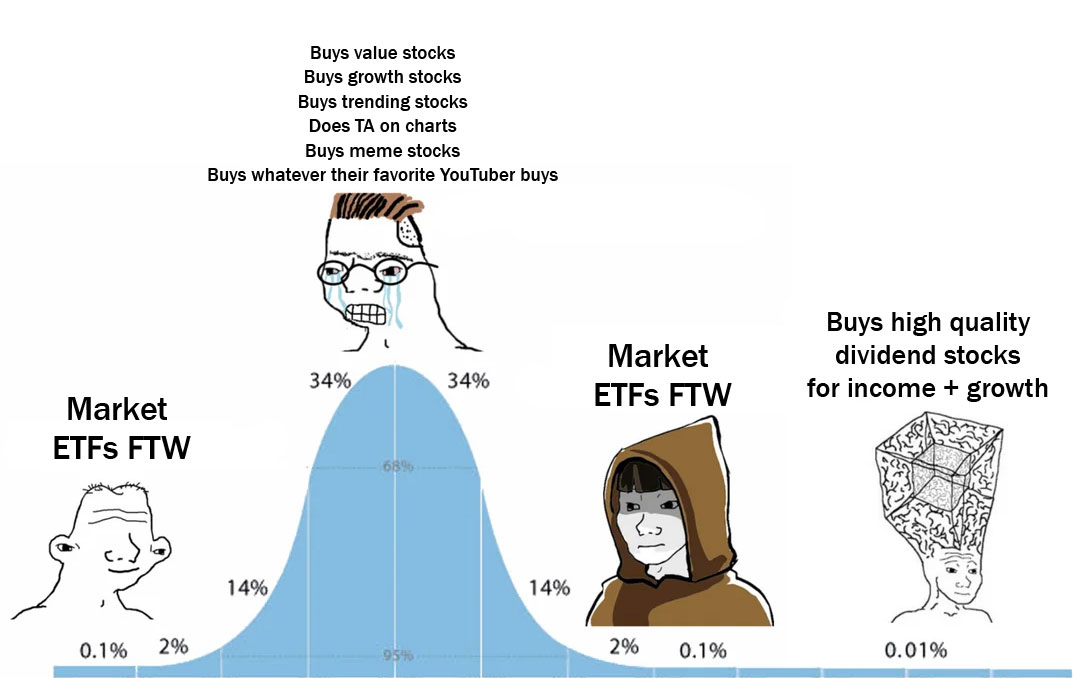
Since March 2022, interest rates have increased, leading to a downturn in the performance of dividend stocks. This has directly impacted retail investors, especially in markets like Singapore, where high-yielding stocks like REITs are popular. Many of these investors have seen significant losses in their investment portfolios.
In 2024, we saw some hope as the Fed began to talk about reducing interest rates. However, over recent months, the hopes of seeing lower interest rates got dashed as inflation remained as stubborn as ever in the US. Now, pundits expect only two interest rate adjustments this year, with some expecting rates to stay high throughout 2024.
With such news, dividend investing has lost its lustre among many investors, who prefer to focus on hot stocks like NVIDIA that can ride the AI wave.
With markets already processing bad news, Dividends Investing stands a good chance of being the dark horse performer for the rest of 2024.
What critics may not understand about dividend investing
Dividend investing has always had its share of critics. One of the strongest theoretical challenges comes from Franco Modigliani and Merton Miller, who came up with the dividends irrelevance theory in the 1950s, which posits that a company’s dividend policy does not affect its stock price or value. This theory has been a mainstay in many finance programs, including the CFA program.
However, recently, in a new book by Daniel Peris, The Ownership Dividend, it has been pointed out that the Dividend Relevance theory came from a different era. In that era, companies did not have much free cash flow, so they needed their cash and some investor injection to keep running. In the current era, companies that generate plenty of free cash flow to sustain relatively high dividend payouts are particularly abundant in Singapore.
It can be argued that something is wrong with the current markets, where folks are unwilling to punish companies that do not pay dividends to investors. For one thing, some valuation models would reason that these stocks are worthless. For another, if an investor’s growth thesis for these companies is proven incorrect, the losses can be massive as none of the capital has been returned to the investor. It can be said that folks who invest in such stocks are speculators rather than investors.
What advantages are there to investing in dividends?
The lack of popularity of dividends counters in an even more unpopular Singapore stock market can be a hidden advantage for the underdog investor.
Firstly, dividends given out to local stocks are not taxed at the personal level. Even if you earn $100,000 in dividends in a particular year, IRAS will not consider this part of your earned income during the income tax assessment exercise.
Furthermore, for folks with a very traditional setup of having stocks in the Central Depository or CDP, dividends can arrive as early as 4 p.m. on the dividend payout date. The sums will come regardless of whether an investor is conscious or lying in a deep coma in the hospital. Your dividend stocks can be used to pay your bills via GIRO.
Another feature is the ridiculously low Price-Earnings or PE ratio of the Singapore Stock market. As of 17th May 2024, the PE ratio of the STI ETF was 10.55. If we invert this number, the earnings yield, a great estimator of long-term real returns, is 9.48%.
Finally, I took the trouble to back-test (on Quants Café) the investment performance of all the STI counters supplemented with ten of the next largest stocks to create a 40-stock universe. From 20 May 2014 to 20 May 2024, the performance of an equally weighted portfolio would have returned 3.1% with a standard deviation of 11.83%. If, instead, I invested in 20 of the stocks with the highest dividend yields, my return would have been 6.02% with a standard deviation of 10.04% over the same period.
This confirms that for Singapore blue chips, picking the high-yielding counters will result in higher returns and lower risks.
How to get started on Dividends Investing in Singapore
The question is, how can a newbie get started investing in this market?
While a diversified position should consist of at least 15 stocks, you can start benefiting from a dividend portfolio by spreading it across just three stocks. ( Dividend yields data taken from Stocks Café on 20 May 2024 )
- DBS ( Ticker: D05 ) – Singapore’s largest bank has a dividend yield of 5.70%.
- Netlink NBN Trust ( Ticker: CJLU ) – This business trust builds and maintains passive fibre networks beneath Singapore and has a yield of 6.2%.
- Frasers Centrepoint Trust ( Ticker: J69U ) is a real estate investment trust with suburban malls. It was chosen because it is listed in the STI and has the lowest volatility amongst all REITs in the STI. It has a dividend yield of 5.55%.
A portfolio that values each component equally should comfortably provide a dividend yield above 5%. DBS investors can benefit from the highest interest rates, while Frasers Centrepoint Trust will do better when interest rates begin to fall.
Why not try dividends investing for size?
With markets focused on sexy AI stocks and technology counters, investors have an excellent opportunity to begin accumulating stocks that can provide a steady income in the foreseeable future. A starter portfolio of $24,000, yielding 5%, would be able to generate an average income of $100 every month.
This can be a powerful game changer in your life.
Want more ways to pick high quality REITs and dividend stocks? I’ll be revealing my strategy live, you can join me here. (p.s. I used the same strategy to retire successfully at 39)

